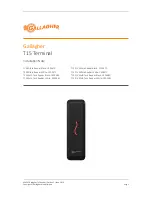
Chapter 4
Signal Connections
©
National Instruments Corporation
4-7
Analog Input Signal Overview
The analog input signals for these devices are ACH<0..15>, ASENSE, and
AIGND. Connection of these analog input signals to your device depends
on the type of input signal source and the configuration of the analog input
channels you are using. This section provides an overview of the different
types of signal sources and analog input configuration modes. More
specific signal connection information is provided in the
section.
Types of Signal Sources
When configuring the input channels and making signal connections,
you must first determine whether the signal sources are floating or
ground-referenced.
Floating Signal Sources
A floating signal source is not connected in any way to the building ground
system but, rather, has an isolated ground-reference point. Some examples
of floating signal sources are outputs of transformers, thermocouples,
battery-powered devices, optical isolators, and isolation amplifiers. An
instrument or device that has an isolated output is a floating signal source.
You must tie the ground reference of a floating signal to your device analog
input ground to establish a local or onboard reference for the signal.
Otherwise, the measured input signal varies as the source floats out of the
common-mode input range.
PFI8/GPCTR0_SOURCE
DIO
—
Vcc +0.5
3.5 at (Vcc –0.4)
5 at 0.4
1.5
50 k
Ω
pu
PFI9/GPCTR0_GATE
DIO
—
Vcc +0.5
3.5 at (Vcc –0.4)
5 at 0.4
1.5
50 k
Ω
pu
GPCTR0_OUT
DO
—
—
3.5 at (Vcc –0.4)
5 at 0.4
1.5
50 k
Ω
pu
FREQ_OUT
DO
—
—
3.5 at (Vcc–0.4)
5 at 0.4
1.5
50 k
Ω
pu
AI = Analog Input
DIO = Digital Input/Output
pu = pullup
AO = Analog Output
DO = Digital Output
Note: The tolerance on the 50 k
Ω
pullup and pulldown resistors is very large. Actual value may range between 17 k
Ω
and
100 k
Ω
.
Table 4-2.
I/O Signal Summary (Continued)
Signal Name
Signal
Type and
Direction
Impedance
Input/
Output
Protection
(Volts)
On/Off
Source
(mA at V)
Sink
(mA
at V)
Rise
Time
(ns)
Bias
















































